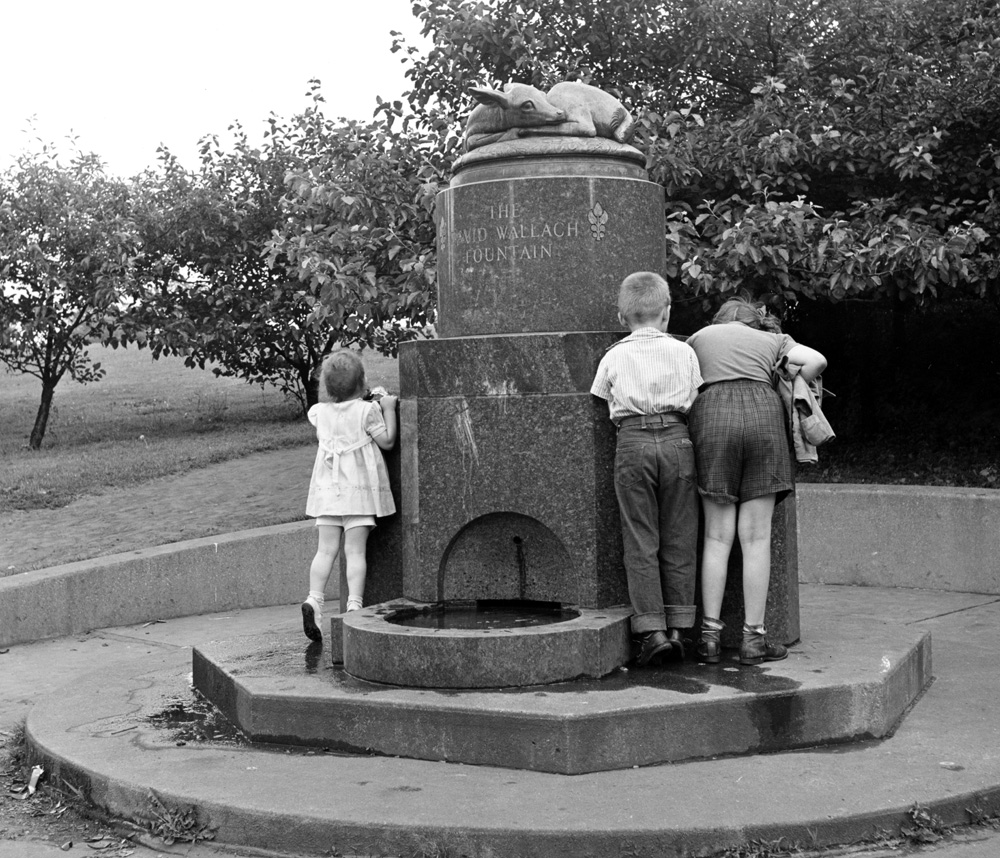 |
| University of Chicago Photographic Archive, [apf2-09143], Special Collections Research Center, University of Chicago Library. |
As with so many women, it’s hard to find information about Elizabeth Haseltine (1894-1950). I have been looking because she’s the artist who created my favorite Hyde Park public art, the fawn on the top of the David Wallach fountain. Her husband, Frederick C. Hibbard (1881-1950) designed the base. I love the contrast of the naturalistic fawn and the Art Deco base.
David Wallach had died in 1894, leaving money to the city for a fountain for “men and beasts.” Nothing happened. Finally, David Wallach’s heirs sued the Park District in the 1930s for an accounting. As a result, a committee for the fountain was formed of the Park District and the heirs. They launched a design competition.
The competition was won by Frederick Hibbard and Elizabeth Haseltine Hibbard of 1201 East 60th Street near the Midway Studios of Lorado Taft. Haseltine taught at the University of Chicago and the Art Institute and assisted Lorado Taft.
 |
| Originally in the Herald. Hibbard and Haseltine showing off the winning design from the Chicago Park District Special Collections |
She specialized in statues of animals, studying the animals at Lincoln Park Zoo for inspiration. Haseltine had three sculptures in the newly finished 1935 Japanese garden: a squirrel, a kingfisher, and a great blue heron carved out of tulipwood and placed near the waterfall entering the lily pond. She liked to work from nature, spending hours at the Lincoln Park Zoo studying her subjects.
 |
| Elizabeth Haseltine working on the clay mock up of the fawn. Tribune October 30, 1939 |
She exhibited regularly in a large annual art show. The Tribune critic called her statue of a cat “whimsical” and “clever.” One year she showed Pegasus as a colt. The Tribune critic said, “This is one of the most graceful and admirable figures one could find in a year’s search. It is delicate, true, simple, and fascinating.” Which is what I feel about the fawn.
The Point was created in the late 1920s when the lakefront was expanded. The photo at this link shows the landfill beginning: http://encyclopedia.chicagohistory.org/pages/10584.html
For a while it wasn't landscaped. The Shoreland valets used it as a parking lot for the guests. But in 1936, the WPA helped finance a new look--the tunnel under what was then called Leif Erickson Drive, electrical, water, and sewer systems, and a new landscape. Alfred Caldwell designed a landscape of an open meadow, native plants, and stone council circles.
As the Point took shape according to Caldwell's vision, the heirs of David Wallach, who were living in the Parkshore and had a front row seat for the changes, wanted David's fountain placed on the Point.
Frederick created the base "along modernistic lines" using Dakota Mahogany granite mined near St. Cloud, Minnesota. There are three fountains for humans on each side and the back, and one fountain for "beasts" at the front. There are abstract floral motifs in the polished granite. The polish enables the stone to withstand the weather. It was dedicated in December 1939, and there the fawn slept through the USO picnics at the Point during the war, the huge crowds of sunbathers during the 1950s, and the Nike missile installation of the 1960s. There she slept until 1981, when she suddenly disappeared.
A dog walker came out from under the tunnel on October 21 and realized there was no fawn. The dog walker immediately contacted the alderman and the police. The Hyde Park Herald printed the fawn's picture and an anonymous donor offered $200 for her recovery.
Fawns sleep all tucked up under brush, even with predators stalking about. They won't move until their mothers return. Haseltine's fawn also waited. A Hyde Parker, poking around a salvage warehouse, suddenly spotted her tucked up and hiding among the architectural detritus. He called the alderman and the Area One crimes unit and the fawn was safe again. The thieves had gotten a mere $150 for it.
When it became known that she had been fenced to the salvage warehouse on October 8 and the full-time Park District supervisor whose office was in the Point fieldhouse hadn't noticed her missing for two whole weeks and hadn't bothered to report the park benches that had been chopped up and vandalized at the same time, the citizens of Hyde Park were incensed. As the Herald said, the patronage-ridden bureaucracy of the Parks could care less about a "small charming beloved landmark in a small charming beloved South Side park" and so the citizens organized the Friends of the Point.
I first wrote a version of this post in 2010. Since then, a detailed account has appeared in a Hyde Park Historical Society article. Check out vol41nos123_autumn2019finalB.pdf (hydeparkhistory.org)

No comments:
Post a Comment